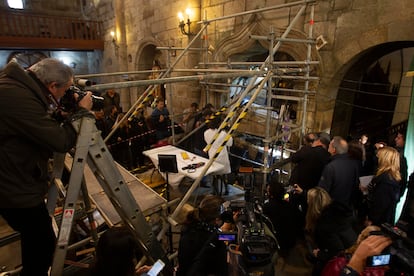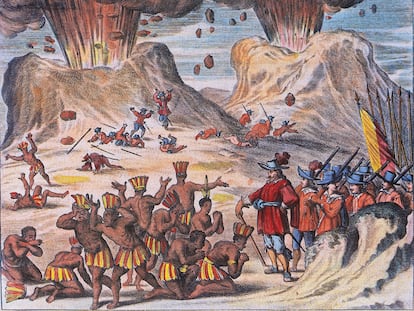Tracing Columbus’s DNA: Two exhumations in Spain seek to determine the explorer’s lineage once and for all
The project will compare genetic remains from the Spanish region of Galicia, with those taken from the navigator’s tomb in Seville. If the results match, it would change 500 years of history

When Christopher Columbus died on May 20, 1506, in Valladolid, Spain, he left behind him a historical legacy and a mystery about his true origins. Contradictory myths have emerged about Columbus’s heritage. The official theory has long held that the navigator who reached America was Genoese. In 1898, another hypothesis posited that the explorer was born in Pontevedra, Spain, the first of five hypotheses that claim that Columbus was of Spanish descent. Portugal, Croatia and Poland have also been mentioned as Columbus’s possible origins.
Now, a project led by José Antonio Lorente, a professor of Forensic Medicine at Spain’s University of Granada, is examining Columbus’s DNA. The historical community and those interested in the explorer are eagerly awaiting the results of the scientific study, which could change the last 500 years of history. After exhuming Columbus’s tomb in the Cathedral of Seville in 2003 and extracting remains of his bones, along with those attributed to his son Hernando and his brother Diego, Lorente began the process of conducting a genetic identification analysis in different laboratories in Italy, the United States and Mexico.
Now nearing its conclusion, this research aims to solve the enigma of the explorer’s identity and origins. The analysis was put on hold for 16 years for “ethical” reasons (and was then prolonged by the Covid-19 pandemic). Because of the incalculable value of the samples taken from the Columbus family, Lorente himself believed that he should wait for better technology to analyze them, one better suited to examining a small amount of DNA. That technology now exists.
Tracing Columbus’s lineage took Lorente’s team to the province of Pontevedra in Spain’s northwestern region of Galicia. That region’s theorists contend that Columbus was born there, and that his relatives are buried there, too. A few days ago, in the San Salvador de Poio cemetery, the research team exhumed fairly well-preserved bones, despite the high acidity of the soil excavated around the burial site. In the first week of November, near the medieval Benedictine San Xoán de Poio monastery, team members recovered possible vestiges of Columbus related to the clan of sailors, experts in the art of navigation, who prospered in the powerful maritime trade that developed in this area in the 15th century. Pilar Rodríguez and Mercedes Vázquez Bertomeu, historians at the University of Santiago, and cultural heritage experts Alicia Padín and Rafael Fontoira worked with the field team in this phase.
The other purpose of the research team’s expedition to this region is located a few miles from Poio, in the Romanesque San Martiño de Sobrán church, in Vilaxoán, a parish in the municipality of Vilagarcía de Arousa, which was an important city during the Middle Ages. On Monday, the researchers opened the imposing solid stone sarcophagus that is believed to house the mummy of Juan Mariño de Sotomayor, an influential clergyman who might be Columbus’s cousin. Some historians hypothesize that Columbus was the bastard son of a descendant of this powerful family of noble landowners, and that a conflict between the family and Spain’s Catholic Monarchs forced Christopher Columbus to hide his true identity in order to achieve his historic feat (the Sotomayors supported Juana la Beltraneja’s claim to the throne over Isabella’s).
Under the watchful eye of archaeologists Antonio Castro and Mateo Alemán, conservator José Aguiño opened the heavy gravestone, while his colleague Sindo Mosteiro documented each step of the process. Going in, the expedition knew that opening the tomb might turn out to be a fiasco, either because it was empty or because the anthropological remains were not well-preserved enough to subject to genetic analysis. After several minutes of suspense, it became clear that was not the case. To the team’s surprise, the remains were in apparently good condition after being buried for five centuries. Inmaculada Alemán, Professor of Anthropology at the Faculty of Medicine of the University of Granada, selected several bones and part of the skull and jaw for a total of seven samples.
If the genetic tests match, Christopher Columbus could actually be Pedro Álvarez de Soutomaior, nicknamed Pedro Madruga, according to one hypothesis. “This is a unique expedition, it’s very exciting, and we hope to be closer to being able to prove our thesis, which was the first to question the admiral’s Genoese origin,” says pharmacist Eduardo Esteban Meruéndano, the president of the Galician Celso García de la Riega Christopher Columbus Association. The organization is named after Celso García de la Riega, the first historian to raise this theory, which was documented at the Geographical Society of Madrid.
December 22 of this year marks the 125th anniversary of the first hypothesis to question Columbus’s Italian origins. “Documents, toponymy and language served as the foundation of a possibility that has been discarded by renowned historians, teachers and academics,” says Eduardo Esteban. He points out that, in 2013, Spain’s Institute of Cultural Heritage authenticated historical documents that support the existence of Columbus’s surname (Colón and de Colón in Spanish) in Pontevedra; which were also used in the Capitulations of Santa Fe (the agreement between Columbus and Queen Isabella I and King Ferdinand II that stipulated the conditions of his famous voyage).
Other theories about Columbus’s origins
Professor Lorente’s scientific research seeks to compile all the theories about Columbus’s origins. These hypotheses place the explorer’s birth in different cities in Spain (Valencia, Castilla-La Mancha, Navarre and Mallorca) as well as three possible locations in Portugal. The theories are based on documentary evidence, and, in some cases, possible DNA remains.
This unusual journey to trace Columbus’s DNA began in 2003 with the exhumation of his remains in Seville. The investigation’s final result will be the basis of a documentary film and miniseries produced by Spanish Television and Story Productions. Emulating the exploration of the mummies of famous pharaohs, the audiovisual project Columbus’s DNA: His True Origins will provide a step-by-step view of the scientific tests and exhumations of Christopher Columbus’s remains conducted by Professor Lorente and a huge team of experts in forensic anthropology, history and archeology.
Genetics laboratories affiliated with the University of Florence and the University of North Texas have also been involved in this process of analyzing Columbus’s DNA. Mexico’s forensic genetics laboratory Zogbi Commercial Distributor will confirm the results. By sharing the samples and subjecting the results to independent comparisons, Lorente aims to ensure the maximum rigor and impartiality of the investigation’s final conclusions. For his part, Eduardo Esteban hopes to find out more about Columbus and end speculation. “This exciting exploration – we still do not know where it will lead us – will put an end to the most disparate and disturbing conjectures about Columbus [...] Some believe that he was the secret son of aristocratic families, while others think he was a spy for King John II of Portugal,” he says.
Tu suscripción se está usando en otro dispositivo
¿Quieres añadir otro usuario a tu suscripción?
Si continúas leyendo en este dispositivo, no se podrá leer en el otro.
FlechaTu suscripción se está usando en otro dispositivo y solo puedes acceder a EL PAÍS desde un dispositivo a la vez.
Si quieres compartir tu cuenta, cambia tu suscripción a la modalidad Premium, así podrás añadir otro usuario. Cada uno accederá con su propia cuenta de email, lo que os permitirá personalizar vuestra experiencia en EL PAÍS.
¿Tienes una suscripción de empresa? Accede aquí para contratar más cuentas.
En el caso de no saber quién está usando tu cuenta, te recomendamos cambiar tu contraseña aquí.
Si decides continuar compartiendo tu cuenta, este mensaje se mostrará en tu dispositivo y en el de la otra persona que está usando tu cuenta de forma indefinida, afectando a tu experiencia de lectura. Puedes consultar aquí los términos y condiciones de la suscripción digital.
More information
Archived In
Últimas noticias
More than 40 Democratic lawmakers urge Trump in a letter to stop his ‘attempts to undermine democracy in Brazil’
The journal ‘Science’ criticizes Trump’s anti-renewable energy policy: ‘The US is failing to benefit from its own innovations’
Cubans hope for a miracle as dengue and chikungunya spread
The long shadow of the father figure in the films of Rob Reiner
Most viewed
- Christian Louboutin: ‘Young people don’t want to be like their parents. And if their parents wear sneakers, they’re going to look for something else’
- Cartels in Mexico take a leap forward with narco-drones: ‘It is criminal groups that are leading the innovation race’
- ‘El Limones’ and the growing union disguise of Mexican organized crime
- Liset Menéndez de la Prida, neuroscientist: ‘It’s not normal to constantly seek pleasure; it’s important to be bored, to be calm’
- The low-cost creative revolution: How technology is making art accessible to everyone










































